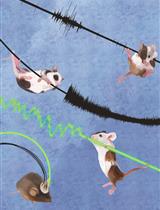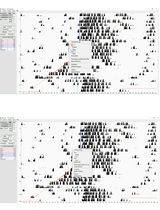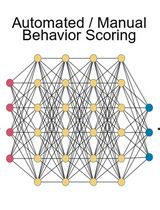- EN - English
- CN - 中文
Measuring Sleep and Activity Patterns in Adult Zebrafish
测量成体斑马鱼的睡眠和活动模式
发布: 2024年06月20日第14卷第12期 DOI: 10.21769/BioProtoc.5014 浏览次数: 1960
评审: Alberto RissoneErica BrescianiSalim Gasmi
Abstract
Sleep is an essential behavior that is still poorly understood. Sleep abnormalities accompany a variety of psychiatric and neurological disorders, and sleep can serve as a modifiable behavior in the treatment of these disorders. Zebrafish (Danio rerio) has proven to be a powerful model organism to study sleep and the interplay between sleep and these disorders due to the high conservation of the neuro-modulatory mechanisms that control sleep and wake states between zebrafish and humans. The zebrafish is a diurnal vertebrate with a relatively simple nervous system compared to mammalian models, exhibiting conservation of sleep ontogeny across different life stages. Zebrafish larvae are an established high-throughput model to assess sleep phenotypes and the biological underpinnings of sleep disturbances. To date, sleep measurement in juvenile and adult zebrafish has not been performed in a standardized and reproducible manner because of the relatively low-throughput nature in relation to their larval counterparts. This has left a gap in understanding sleep across later stages of life that are relevant to many psychiatric and neurodegenerative disorders. Several research groups have used homemade systems to address this gap. Here, we report employing commercially available equipment to track activity and sleep/wake patterns in juvenile and adult zebrafish. The equipment allows researchers to perform automated behavior assays in an isolated environment with light/dark and temperature control for multiple days. We first explain the experimental procedure to track the sleep and activity of adult zebrafish and then validate the protocol by measuring the effects of melatonin and DMSO administration.
Key features
• Allows an isolated and controllable environment to carry out activity and sleep assays in juvenile and adult zebrafish.
• Measures activity of zebrafish in life stages later than early development, which requires feeding animals during the assay.
• Requires use of a commercially available equipment system and six tanks.
• The activity of zebrafish can be tracked for five days including an acclimation step.
Keywords: Adult zebrafish (成体斑马鱼)Background
Sleep is a conserved behavior despite introducing some disadvantages to the organism, such as limiting responsiveness to the environment and preventing food foraging, which are critical activities for animals [1]. We spend nearly one-third of our lifetime sleeping. Although negative consequences of chronic sleep deprivation have been well-documented [1], the function of sleep is not fully known [2]. Major topics in sleep research include the investigation of why we sleep, what biological processes occur during sleep, and how sleep is regulated. Model organisms including zebrafish have been instrumental in addressing these fundamental questions in sleep research. Zebrafish meet all the behavioral criteria for defining sleep [3]. Because electrophysiological recordings of brain activity are not accessible in zebrafish, sleep is defined based on activity; one minute of inactivity in larvae [3,4] and six seconds of inactivity in adults [5] are defined as sleep. Sleep depth and arousability are possible to measure in larvae as well [6,7]. We and others have successfully identified sleep phenotypes in larval zebrafish when drug compounds were administered to their environment [8,9] and when particular genes were targeted via CRISPR/Cas9 mutation [6,10–12]. Nevertheless, there is a need to measure activity patterns and sleep in adult stages to seek answers to the following questions [13]:
1) Do sleep disturbances persist in juvenile mutant fish and adult mutant fish?
2) Do the genes of interest or the administered drug have a developmental (only at larval stage) role or a regulatory role (also at adult stages) in sleep?
For example, overexpression of the gene of interest via heat shock induction in a knockout model can be tested to see if sleep phenotypes at different stages of life are rescued. If the phenotype is rescued in larvae but not in adult fish, it indicates that the mutation irreversibly affects developmental circuits controlling sleep. Heat shock induction to mediate conditional gene expression has been applicable in juvenile [14] and adult zebrafish [15]. Sleep/wake patterns in adult zebrafish have been reported in previous studies that employed homemade solutions [5,7,16]. The methodology we propose here includes the use of a commercially available system, which ensures standardized and reproducible measurements. Sleep and activity phenotyping in larval zebrafish is high throughput; it is possible to include 96 animals in one assay [4]. Such assays in older age groups require the use of much larger tanks to allow normal swimming and exploration; therefore, one can phenotype behaviors of only 6–8 animals at once. We employed this automated video tracking in adult zebrafish (5 months old) and validated our protocol by administering melatonin, a known sleep-promoting compound. We demonstrated a sharp decrease in activity and wakefulness in adult zebrafish compared to the DMSO controls. Further studies are needed to carry out more detailed analyses of sleep parameters such as sleep bout length, sleep latency, and sleep bout numbers in age groups older than larval stages.
Materials and reagents
Biological materials
Adult wild type zebrafish (AB line). Adult zebrafish are housed under a 13:11 h light/dark cycle at the zebrafish core facility of the Children Hospital of Philadelphia.
Note: If possible, fish should be of equal size and pigment. Although the measure is meant to detect the center of the body, discrepancies can be found when comparing fish of drastically different sizes/pigments.
Reagents
Water from tank system (Aquaneering, San Diego, USA)
Gemma micro zebrafish food 150ZF (Skretting, Gemma micro-150)
Tap water to warm up and circulate around the tanks
Laboratory supplies
Six zebrafish breeding tanks, 1 L capacity [Aquaneering, ZHC100T (tank) and ZHC100L (lid)]
Equipment
Zebracube and regulator (ViewPoint Life Sciences Inc)
Zebracube is the chamber that houses juvenile or adult zebrafish during the experiment. It is connected to a computer and software that enable automated video tracking under cycling lights. A camera inside the Zebracube captures data based on the settings defined in the software by the researcher. The regulator facilitates circulation of warm water (28.5 °C) in and out of the water bath where the tanks are placed.
Temperature control unit (Julabo GmbH, model: 200F)
The temperature control unit heats tap water to 28.5 °C in order to keep zebrafish at the optimal growth temperature during the experiment.
Software and datasets
ZebraCube v5.18.0.0 (Viewpoint Life Sciences, Inc., access date, 09/26/2021)
Microsoft Excel (Excel 2016, access date, 02/16/2024)
MATLAB v2021b (Mathworks, https://mathworks.com, access date, 02/16/2024)
GraphPad Prism V10 (access date, 02/16/2024)
Procedure
文章信息
版权信息
© 2024 The Author(s); This is an open access article under the CC BY-NC license (https://creativecommons.org/licenses/by-nc/4.0/).
如何引用
Doldur-Balli, F., Zimmerman, A. J., Seiler, C., Veatch, O. and Pack, A. I. (2024). Measuring Sleep and Activity Patterns in Adult Zebrafish. Bio-protocol 14(12): e5014. DOI: 10.21769/BioProtoc.5014.
分类
神经科学 > 行为神经科学 > 睡眠与觉醒
您对这篇实验方法有问题吗?
在此处发布您的问题,我们将邀请本文作者来回答。同时,我们会将您的问题发布到Bio-protocol Exchange,以便寻求社区成员的帮助。
Share
Bluesky
X
Copy link











